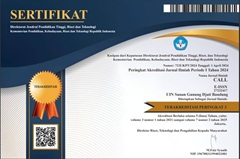DEMON AS FORM OF SATIRICAL STATEMENT IN DRAMA THE TRAGICAL HISTORY OF DOCTOR FAUSTUS
DOI:
https://doi.org/10.15575/call.v3i2.12503Abstract
This study focuses on a word or line that is identified as satire in a drama entitled The Tragical History of Doctor Faustus. The data was taken in the form of dialogues from the characters. Demon as a satirical expression means that the words or line identified as satire was built by several elements that are attached with demon characteristics (demonic). Demon is a creature who has clear characteristics as a bad set. The bad character of the demon is representative of satire. The character demon is a representation of ugliness or evil of the object criticized in the drama The Tragical History of Doctor Faustus. Researchers used the descriptive analysis method by Ratna (2004) in conducting this research. Descriptive analysis is a method used to analyze data and facts in the text and then interpret them. The researcher used two theories in seeing the story. Inter-relationship principle and semiotic.  The results of this research found three important elements in accordance with the topic of this research. The first is the antagonist character Mephistophilis, the demon. The second is the allusion to Franciscan Friar. Third, the phrase holy shape becomes the devil best is satire. Thus, the combination of elements leads to a demon as a form of satirical expression.
Keywords: Satire, Demon, Allusion
References
Abrams, M. (1999). A Glossary of Literary Terms Seventh Edition. Boston: Thomson Learning, Inc.
Abrams, M., and Harpham G. G. (2012). A Glossary of Literary Terms Tenth Edition. Boston: Wadsworth, Cengage learning.
Anderson, C, C. (2018). Franciscan Prophets and the Inquistion (1226-1326). New York: Fordham University. Retrieved from:
Religions | An Open Access Journal from MDPI
Condliffe, P. (2020, September 27). Literary Techniques: Allusion. Retrieved from: https://www.matrix.edu.au/literary-techniques-allusion/
Damono, S. J. (2016). Buku Apresiasi Seni: Bilang Begini Maksudnya Begitu. Jakarta: PT Gramedia.
Diyanni, R. (2004). Literature Approaches To Fiction, Poetry, And Drama. New York: McGraw-Hill
Griffin, D. (1994). Satire: A Critical Reintroduction. Kentucky, UK: The University Press of Kentucky.
Guiley, R. (2009). The Encyclopedia of Demons and Demonology. New York: Facts On File. Retrieved from
https://epdf.tips/queue/the-encyclopedia-of-demons-and-demonology.html
Muhsyanur, M., Larisu, Z., Sanulita, H., Ertanti, D. W., & Widada, D. M. (2022). Indonesian netizens expressions potentially satire with the COVID-19 pandemic on social media Facebook: A digital ethnoliteration research. Linguistics and Culture Review, 6(1), 55-69.
Retrieved from
https://doi.org/10.21744/lingcure.v6n1.1942
Ratna, N. K. (2004). Teori, Metode, dan Teknik Penelitian Sastra. Denpasar: Pustaka Pelajar.
Simanjuntak, Rahayu and Fauzi. (2016). Figurative Language in Westlife’s Second Album Coast to Coast. Riau: University of Pasir Pengairan.
Downloads
Published
Issue
Section
Citation Check
License
Authors who publish in CALL agree to the following terms:
- Authors retain copyright and grant the journal right of first publication with the work simultaneously licensed under Attribution-ShareAlike 4.0 International (CC BY-SA 4.0) License that allows others to share the work with an acknowledgment of the work's authorship and initial publication in this journal.
- Authors are able to enter into separate, additional contractual arrangements for the non-exclusive distribution of the journal's published version of the work (e.g., post it to an institutional repository or publish it in a book), with an acknowledgment of its initial publication in this journal.
- Authors are permitted and encouraged to post their work online (e.g., in institutional repositories or on their website) prior to and during the submission process, as it can lead to productive exchanges, as well as earlier and greater citation of published work (See The Effect of Open Access).




